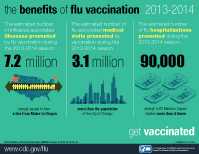New CDC Reports Shows Benefits of Flu Vaccine Last Season But Fewer Than Half of Americans Say They Have Been Vaccinated this Season
Benefits of Flu Vaccination
 Benefits of Flu Vaccination [826 KB, 1 page]
Benefits of Flu Vaccination [826 KB, 1 page]
New! GIF Images:
"City Population" 675x276 [23 KB]
"Stadium" 675x276 [23 KB]
"Stadium Small" 328x184 [10 KB]
Agency urges vaccination as well as flu treatment with antivirals this season
The Centers for Disease Control and Prevention (CDC) today reported that flu vaccination last season prevented an estimated 7.2 million flu-associated illnesses and 90,000 flu hospitalizations. The agency also said that only 40% of people in the U.S. had reported getting a flu vaccine this season as of early November 2014, numbers similar to the estimates from this time last season. This information was released as the agency marks the 9th National Influenza Vaccination Week (NIVW), a national observance designed to support ongoing flu vaccination into the holidays and beyond.
The 2013-2014 influenza vaccine program impact data was released in a Morbidity and Mortality Weekly Report (MMWR) dated December 11, 2014. In this report, CDC used a model first published in June 2013 in PlosOne to estimate the benefits of flu vaccination. These 2013-2014 estimates represent a 17% reduction in the number of flu illnesses and hospitalizations that would have occurred last season in an unvaccinated population.
The report also underscores the severity of flu; estimating that there were 35.4 million influenza-associated illnesses, 14.6 medically attended flu illnesses, and 397,000 flu hospitalizations in the United States last season. The 2013-2014 flu season was characterized as "moderately severe," with the H1N1 pandemic virus predominating in the United States for the first time since the 2009 pandemic. The report also notes that if vaccination rates were improved to 70 percent, another 5.9 million flu illnesses, 2.3 million medically attended illnesses, and 42,000 flu hospitalizations could have been prevented.
Flu is unpredictable and every season is different. CDC held a telebriefing last week to discuss the current flu season, noting that H3N2 flu viruses are predominant so far. H3N2-predominant seasons are often associated with more hospitalizations and deaths, especially in young children and older people. The agency also highlighted laboratory information indicating that about half of analyzed H3N2 viruses this season are different from the H3N2 vaccine virus; a factor which may reduce how well the vaccine protects against those drifted H3N2 viruses.
Despite the detection of drifted viruses, CDC continues to recommend flu vaccination as the best way to protect against the flu. It's not possible to know what viruses will circulate over the course of the flu season and the vaccine protects against three or four different viruses. Also, it's possible that vaccination may still provide some protection against the drifted viruses, lessening severe flu-associated outcomes like hospitalization and death.
CDC also posted reports on its FluVaxView website on estimated flu vaccination uptake so far this season. National early-season vaccination coverage estimates are that 40% of Americans 6 months and older had received a flu vaccination by early November 2014 (40% of adults and 42% of children). This is similar to flu vaccination coverage last season at the same time.
Other online coverage reports indicated that vaccination among pregnant women (44%) and health care providers (64%) is about the same as it was this time last year. Among health care providers, the agency again noted high vaccination rates among pharmacists (87%), nurse practitioners/physician assistants (86%), physicians (82%), nurses (81%), and other clinical professionals (72%). Flu vaccination was lowest among assistants or aides (47%) and administrative/non-clinical support staff (59%).
While vaccination is still the first and best way to prevent flu, CDC also recommends the use of influenza antiviral drugs as a second tool to fight flu and the complications it causes. Antiviral medications are not a substitute for vaccination (which prevents flu), but are a second line of defense to treat flu illness. Treatment with antiviral drugs is especially important for people at high risk of serious flu complications or people who are very sick with flu.
NIVW was established by CDC and its partners in 2005 to underscore the importance of continuing flu vaccination throughout the flu season. Past flu vaccination coverage estimates have shown flu vaccination activity drops quickly after the end of November. However, peak weeks of influenza activity have occurred in January through March in about 80% of seasons during the past 20 years, and significant circulation can occur as late as May, meaning that vaccination after November could still offer substantial protective benefit.
- Page last reviewed: December 11, 2014
- Page last updated: March 14, 2016
- Content source:
Error processing SSI file


 ShareCompartir
ShareCompartir